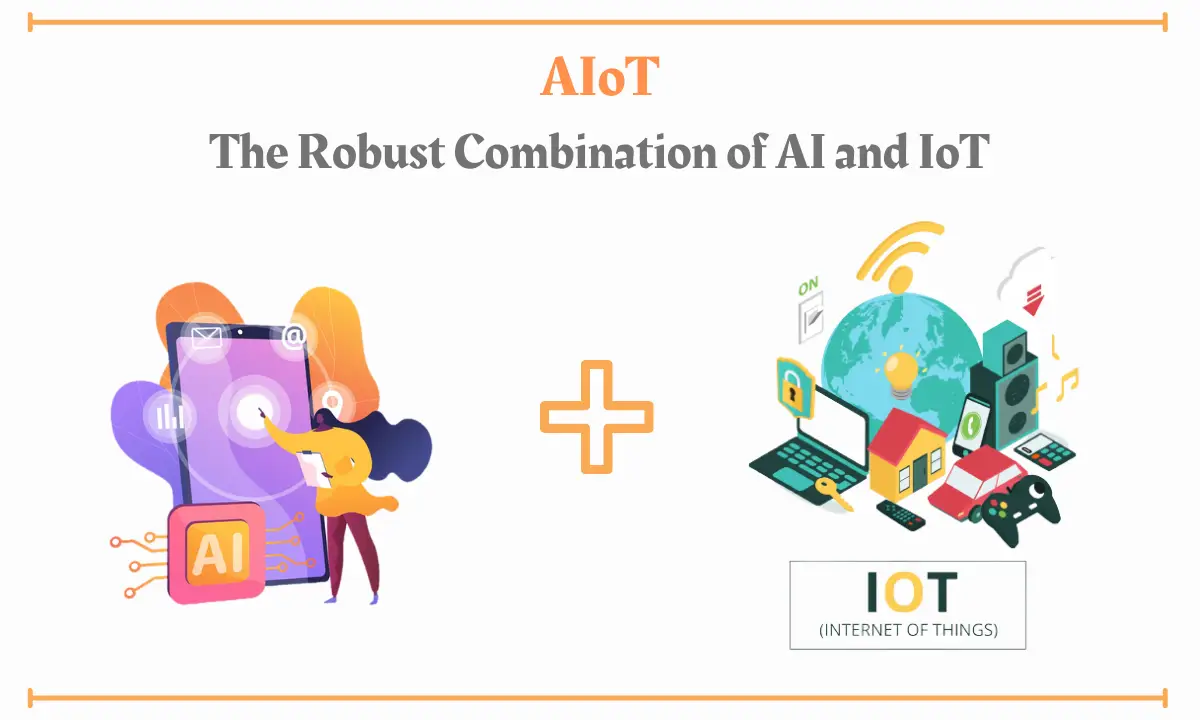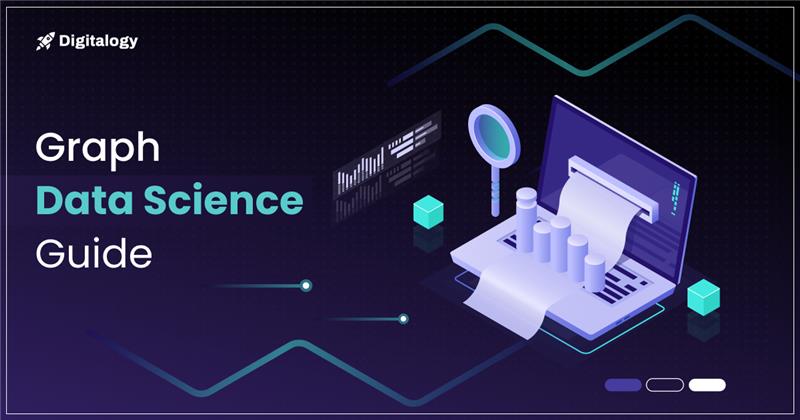The Union of Artificial Intelligence and the Internet of Things has given rise to a powerful technology “AIoT”. It has made people’s lives more convenient by giving machines the ability to think independently and make their own decisions without human guidance. This is a marvel on its own. Businesses have to realize and unleash the full-fledged potential of AI and IoT.
What is Artificial Intelligence?
Artificial Intelligence is the technology with the help of which machines can perceive, learn, solve complicated problems, and make analyses just like humans. The machines exhibit traits similar to that of humans. 3 main steps constitute the whole functioning of AI- For example- self-driving cars can decide which direction to take, the speed, etc.
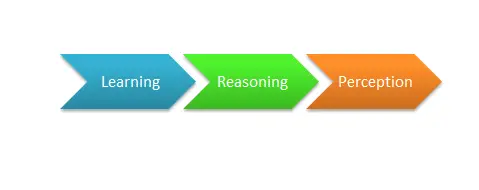
What is the Internet of Things(IoT)?
The short form of the Internet of Things came into existence when in 1999, Kevin Ashton mentioned it in his presentation on Procter and Gamble.
IoT refers to the wide assemblage of physical devices connected to the internet via a wireless network to collect and share data. Here are some examples of IoT – air conditioners, smartwatches, and smart cars.
A survey conducted by Business Insider gave jaw-dropping insights that by 2027 the number of IoT devices would reach 41 billion as compared to 9 billion in 2009.
How Do IoT Devices Function?
All IoT devices contain sensors that are responsible for the streaming of information through the internet.
All of these devices follow 5 basic steps-
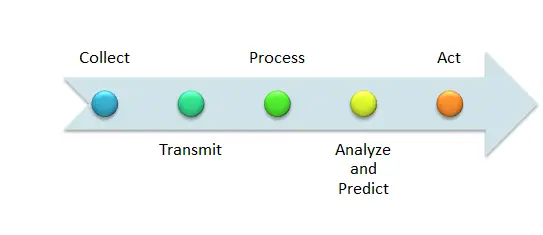
Let’s understand each step in far more detail-
1. Collection of Data
All the IoT devices have sensors that are responsible for them. A single sensor can collect different types of information.
2. Transmitting Data
The collected data is then sent to the cloud for storage. Since it’s difficult for organizations to store such a hefty amount of data, the cloud exists to solve this problem and reduce additional data storage costs.
3. Processing of Data
Raw data needs processing to turn into meaningful information. During processing, relevant data is filtered out, and cleansed, and various AI algorithms are applied to ensure data accuracy and precision.
4. Analyzing and Making Various Predictions
The process data is then subjected to multiple machine learning and deep learning algorithms to make forecasts.
5. Act
At this stage, AI plays its part. IoT devices’ responsibility is to provide data, whereas artificial intelligence makes smart decisions through its creativity.
These 3 emerging technologies add to the power of IoT, making it super powerful.
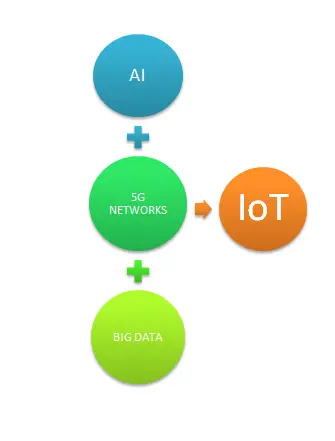
- Artificial Intelligence – The advanced algorithms allow machines to gather, process, and analyze information similar to humans with almost no errors and make predictions accordingly.
- AIoT in 5G Networks – High-speed internet is a necessity for real-time data processing.
- Big Data – Big volumes of data are processed from a wide variety of sources within a few seconds.
IoT Has Certainly Become a Big Fuss These Days. Why?
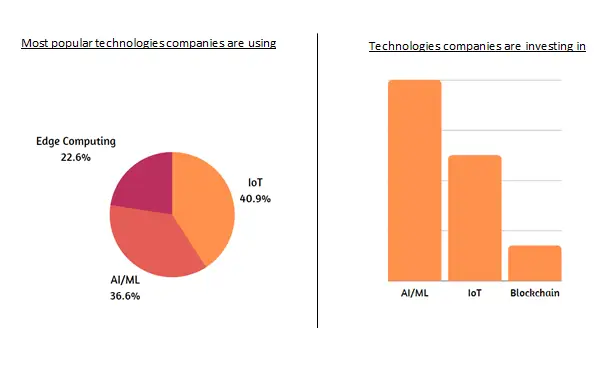
The increasing popularity of Artificial Intelligence and IoT is due to the benefits that it offers.
It is visible that AIoT is creating an aggregated ecosystem of greater value for the companies as well as the end-users.
Startups and well-established companies prefer to employ AI to unleash the full potential of IoT. Vendors of IoT like Amazon, and Microsoft have started merging AI capabilities into IoT applications.
What is AIoT?
Commonly referred to as the artificial intelligence of things or AIoT, both Artificial Intelligence and IoT are self-sustaining bodies capable of doing extraordinary things. Artificial Intelligence’s work is to decipher data with machines’ intelligence; on the other hand, the Internet of Things is responsible for collecting data with the help of various compiled sensor devices.
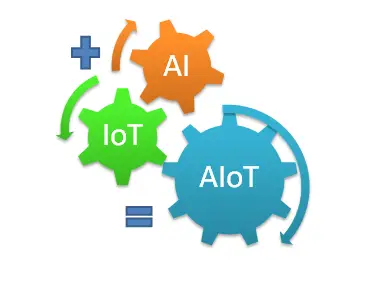
IoT helps to gather an enormous amount of data from a wide array of sources. Being complex in nature makes this huge chunk of data from multiple sources difficult to comprehend. When merged with AI, all these tasks become a piece of cake.
It is evident that ai and IoT together will steer the technological world in the near future. Considering the recent scenario, the business world is witnessing a significant change by utilizing a combination of Ai and IoT.
The convergence of Artificial Intelligence and the Internet of Things can alter how various businesses operate as this blend will create machines credible enough to make smart decisions on their own without any interference from humans.
The evolving collaboration between ai and IoT promises us an astute future. The TSMC infographic illustrates all the revolutionary technologies and trends that AIoT holds for us!
Let’s take a glance at these two individuals.
Artificial Intelligence and IoT
It is presumed that each and every IoT device creates around 1 billion GB of data about our day-to-day activities via the internet.
As mentioned earlier, by 2027, there will be 42 billion devices worldwide to be connected with IoT. Isn’t this amazing?
With so many devices around, it’s obvious that a huge chunk of data will be collected too. To make this easier, AI plays its part and helps IoT by lending its amazing capabilities.
Artificial intelligence and IoT help to achieve the following:-
- Obtaining relevant and meaningful insights from the data by analyzing it.
- This union ensures accurate forecasts.
- Confidentiality of data is maintained.
- Personalization becomes easy.
- Ensures utmost security against cyber attacks.
What Distinguishes AIoT and IoT?
You must be in a dilemma; if IoT is already doing wonders, why is there a need for AIoT?
The simplest answer to this daunting question is “AIoT is the superior version of IoT.
To understand this more clearly, it’s better to refer to the distinction between these two-
Forbes explained this quite well, stating, “Imagine IoT as a digital nervous system then the mastermind, i.e., the brain that controls all the functions would be AIoT.”
Earlier IoT devices were considered just for collecting information. Conversely, AIoT is far different from IoT as it is involved in analyzing data patterns and giving relevant information to make the best and most effective decisions. It can often make decisions on its own, thereby eliminating wasting hours and network capabilities.
Benefits of AIoT-
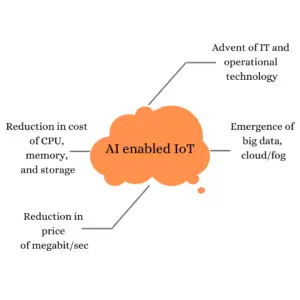
- For Businesses
Various businesses are employing AIoT for the sole purpose of generating real-time information by collecting and analyzing real-time data.
- Reduction in manual labor, most of the tasks are done by the machines, ensuring productivity and performance efficiency. This also lessened the business’s operational costs.
- It takes minimum time to market products and services.
- Better for maintaining customer relationships with the help of bots and speech recognition.
- It gives in-depth insights for better business decisions.
- Processes raw data and provides valuable information in no time.
- A company’s brand image improves if it employs high technology in its functioning.
- For Customers
If the business functions well, it’s obvious that the benefits will automatically be transferred to the customers.
- Since this combination generates deeper insights, customers get a more inbound and better experience throughout their journey.
- This enhances the personalization aspect by identifying the behavioral patterns and preferences of the customers.
- The wearables monitor important information related to body functions precisely, thereby ensuring a great customer experience.
- As The performance of the product improves, better versions are frequently available to the customers.
The advantages that AI and IoT are not only limited to these two categories. Other benefits are as follows-
1. Upliftment of Customer Satisfaction
Let’s understand this with an example. The thermostat that we have installed in our homes automatically detects temperature drops and rises and adjusts without human help. This automation aids the consumer, as he doesn’t need to adjust the temperature; the machine automatically reduces manual labor and enhances the consumer’s end-to-end experience.
2. Improved Risk Management
AIoT devices enable companies to manage various risks such as financial and cybersecurity risks efficiently. When combined with AI, IoT devices help every company analyze these risks and provide real-time data that enables quick actions. A clear business risk management plan that uses AI and IoT can help spot and resolve potential issues before they escalate, allowing businesses to mitigate risks proactively. This real-time monitoring can significantly reduce the chances of risks turning into larger problems that could disrupt business operations.
3. The Advent of New Products and Services
iRobot Roomba is the perfect example to explain this point. This vacuum cleaner has sensors attached to it, identifying the dirty spots and detecting any hindrance while cleaning.
The amalgamation of AI in IoT has resulted in the tremendous emergence of new technologies with the ultimate aim of satisfying human needs as much as possible.
4. Eliminating the Unplanned Downtime
Predictive Maintenance is the keyword here. This merely enables us to predict whether a machine requires any maintenance or thereby ensures that proper steps will be taken to correct the failure without causing any hindrance to the normal functioning of work.
5. Helps in Real-Time Monitoring
For example, Google Maps always comes to the rescue whenever we feel stuck. It displays the real-time shortest routes with an estimated time frame by considering the volume of the traffic available.
AIoT Artificial Projects
- Self-Driving Cars
The biggest example of this is the self-driving cars of Tesla. By combining the abilities of AI in IoT, this car can detect any anomalies in the surroundings and the roads’ conditions, appropriate speed, and weather conditions.
- Wearables
Smartwatches are often referred to as wearables. Gartner’s recent survey suggests that these wearable devices’ revenue will see a hike up to $100 billion by 2025.
These devices have contributed majorly to the sports and health industry.
- Traffic Management System
Management of traffic is the need of the hour, especially in the city areas. It’s cumbersome for humans to manage the traffic effectively; hence AIoT has done wonders to solve this problem. Drones are the solution for this; they can track a wider range of areas and estimate traffic congestion, thereby making effective decisions.
A similar device has been designed by Alibaba Group, known as ET City Brain. It can recognize accidents, change the traffic lights accordingly, and many more useful functions.
- Smart Homes
This is a new concept in which all the house’s physical devices are connected to one another through IoT, and with AI, they make intelligent decisions like when to switch on/off the lights, television or when to lock the main gates, etc.
- Face Detectors
In the COVID period, face detectors have served their purpose righteously. They are currently being used in various public faces to check whether people are wearing masks or not. Face detectors are also useful in crime investigations and are often used in offices for the purpose of attendance.
- Robots in the Manufacturing Industry
The manufacturing industry has already employed AIoT in its day-to-day functioning.
The robots handle almost all the tasks to ensure every process is carried out with utmost precision without any errors. With advanced algorithms coming into the picture, everyday robots have become smart enough to learn from new data.
- Retail Analytics
In retail analytics, cameras and sensors are present to observe customers’ movements to predict whether they will go to the checkout line or not. With the help of this, the checkout time could be reduced, and the cashiers’ productivity could be increased due to organized staff.
- Advanced Thermostats
Our houses are now equipped with thermostats to detect any slight temperature change and adjust it according to the users’ preferences.
This has no doubt increased the satisfaction levels of the consumers as well as reduced minute labor also.
Wrapping Up!
The sole motive behind AIoT is to make the lives of people as convenient as possible. This amazing technology has given people access to control remotely every physical appliance that they own. Esteemed organizations and people invest in these high–tech technologies to get a hold of the easy life.
So, what are you waiting for? Take advantage of these magnificent creations of mankind and make your life a lot more effortless.
If you have any queries regarding this topic, feel free to reach us anytime.
We are always happy to help!
Frequently Asked Questions (FAQs)
Ans: Artificial intelligence (AI) and the Internet of Things (IoT) are combined to form AIoT, or Artificial Intelligence of Things. IoT is the network of physical things that can gather and share data, whereas AI is the capacity of computers to learn and make judgments without being expressly programmed.
Ans: Here are a few advantages of AIoT:
Improved effectiveness: By gathering and analyzing data in real-time, AIoT may be utilized to improve the effectiveness of operations. Businesses may use this to find places where they can save costs or increase production.
Personalized experiences: By gathering information on users’ interests and behaviors, AIoT may be used to customize experiences. This can be used to suggest goods, services, or information that the user is more likely to find interesting.
Improved Safety: AIoT may be used to increase safety by keeping an eye out for possible threats and taking preventative measures. For instance, AIoT may be used to monitor machinery for symptoms of wear and tear or to monitor traffic for indicators of congestion or accidents.
New business prospects: By giving companies new methods to gather data, evaluate data, and make choices, AIoT can open up new business options.
Ans: There are many examples of AIoT in use today:
Smart homes: AIoT is used in smart homes to automate functions like lighting up, changing the thermostat, and locking doors.
Autonomous vehicles: Autonomous vehicles use the AIoT to gather data from sensors and make driving choices.
Medical equipment: Medical devices utilize AIoT to gather data on patients’ health and communicate it to doctors for monitoring, such as pacemakers and insulin pumps.
Industrial machinery: AIoT is used by industrial machinery to gather data on its operation and spot possible issues before they lead to a breakdown.
Ans: Here are a few difficulties with AIoT:
Security: Because AIoT devices are frequently interconnected with the internet, they are susceptible to hacker assaults.
Privacy: Because AIoT devices capture so much user data, privacy issues are raised.
Cost: Developing and deploying AIoT devices can be costly.
Ans: AIoT has a very promising future. We may anticipate many more ground-breaking and avant-garde applications to emerge as technology advances. Many facets of our lives, including how we work and travel as well as how we live at home, might be revolutionized by the AIoT.

